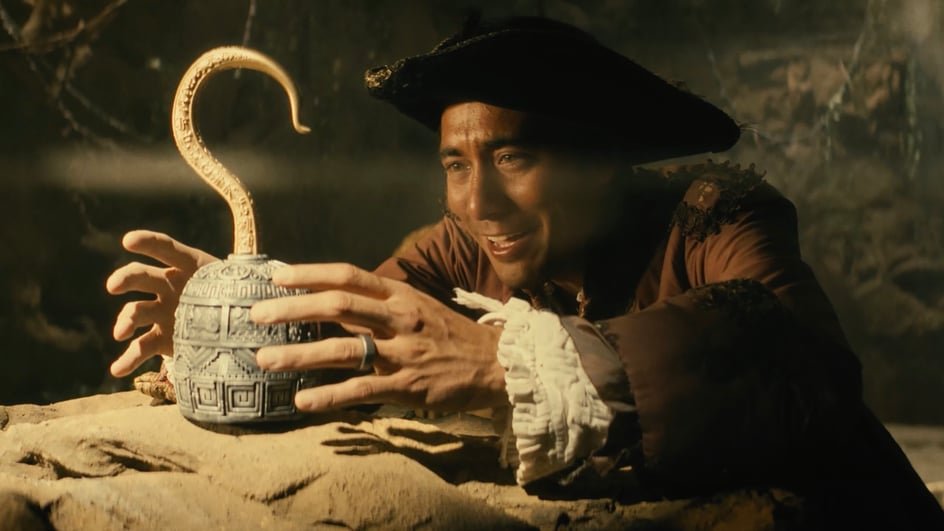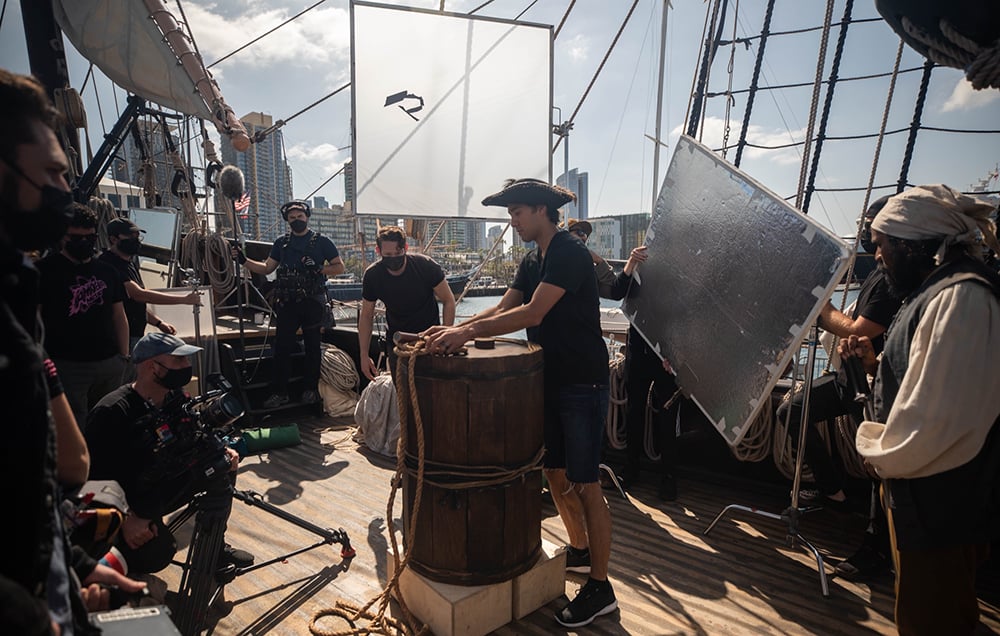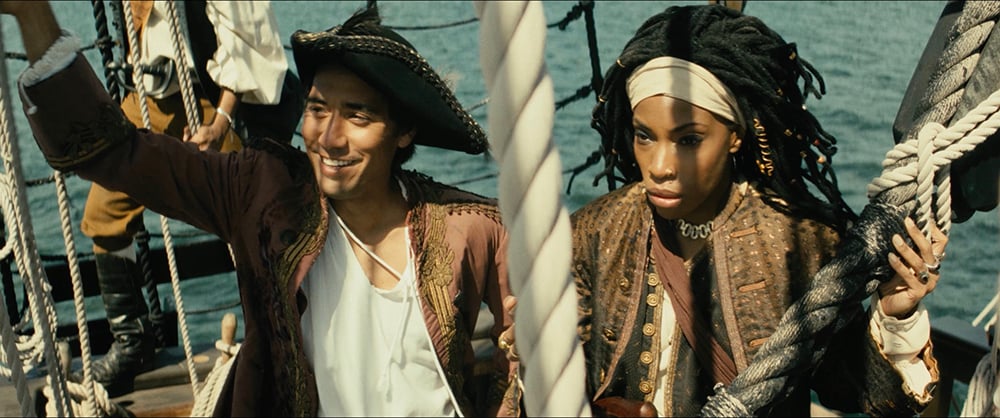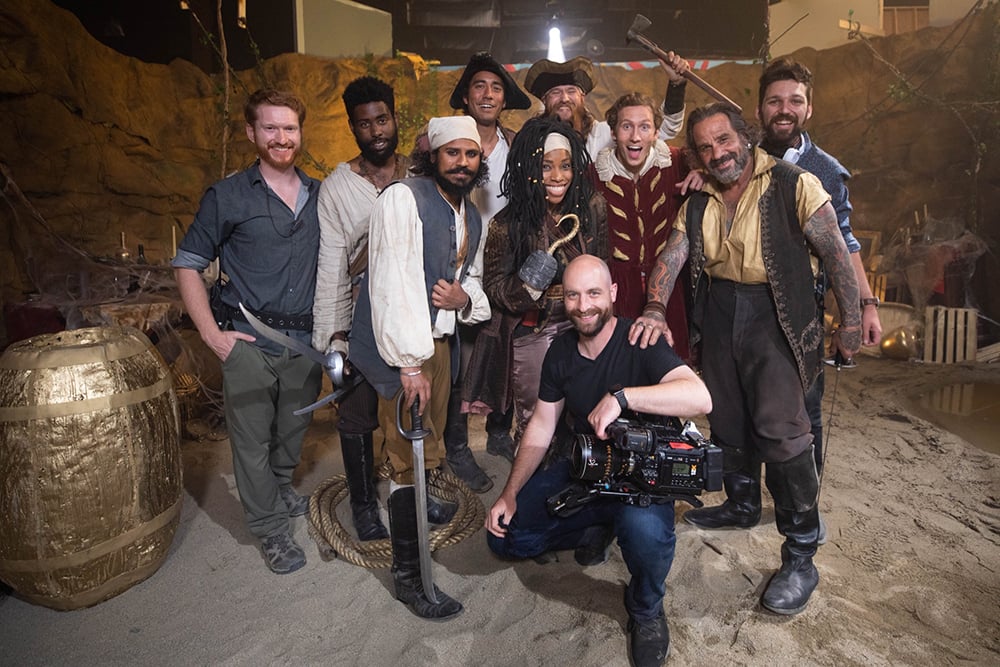
Dec 13, 2022
Let us present another example of the bold new world we live in as we explore how viral YouTube artists like Zach King can move up from short magic trick Vines into full-blown feature film worthy short films which look like their own spin-off adventures of Captain Jack Sparrow from the Pirates of the Caribbean franchise.
Using Blackmagic both in terms of production tricks and cameras like the URSA Mini Pro 12K (plus others) and some fanciful finishing techniques in DaVinci Resolve, the team behind King’s latest viral sensation offer a great example of how even YouTube creators are able to level up their production game to near Blockbuster status with the right mix of skill and resources.
We chatted with the creative team behind King’s Stranded 2 short film (a follow up to his Stranded On Treasure Island original which has garnered over 800k likes and 18 million views) including director Josh Fapp, DP William Hellmuth, producer Julianna Ulrich and colorist Wes Langdon about their unique challenges faced and workflows used in bringing this ambitious project to life.
Soundstripe: How did you first come across this opportunity to work with Zach King on this project?
Josh Fapp: I have worked full time with Zach for the past two years as a producer and director. We’ve made a lot of his videos together over the years and it was amazing to get the opportunity to direct in a more traditional way.
William Hellmuth: I shot my first project with Zach King (Nerf Nation) years ago and continued working with his team from time to time. I’ve always enjoyed the experience. For Stranded 2, producer Julianna Ulrich actually brought up my name with Josh. So, Josh and I had a conversation about the film and what he wanted to do with it. I could tell right away it would be a great fit, so I went for it.
Julianna Ulrich: I've produced for Zach King in the past (we both went to Biola University) and when the director, Josh, needed a producing partner, my name came up and we chatted and knew it would be a great fit so he could focus more on the directing side of things and pass off some producing responsibilities.
Wes Langdon: I’ve been close friends with cinematographer William Hellmuth for several years now. We’ve worked together on a good list of projects in various capacities, so when he got booked to do the Stranded sequel, he hit me up about putting together a show LUT so they could go into the project with some more intentional look.
Soundstripe: The first short did a lot of work to establish the look and style, what was your approach for building on that vision for this sequel project?
Fapp: At the end of the first Stranded, Zach said if the video got 250k likes we would make a part 2. Much to our surprise, the fans far exceeded that goal with 810k likes and around 18 million views right now! A little more than a year ago, we really hunkered down and started writing Stranded 2.
It’s always scary doing a sequel to a successful video. So from the start, we were asking ourselves what we could do to make this one just as good or better. We knew that we wanted to pick up right where we left off, with Zach and Nate being captured by the pirates. From there, we started throwing ideas at the wall to see what would stick. “It would be awesome to have a real pirate ship!” “We should have Zach and Nate sword fight!” “What if there was an artifact that turned whatever it touched to gold?!” It took many many bad ideas to get to the good ones.
The hope was to increase the production value with magical action/adventure sequences but also have a grounded story for Zach and Nate about friendship. I think Zach and Nate really pulled that off in their performances.
Hellmuth: Well, it turns out that I also shot the first Stranded film. It’s interesting because the first film was done with very minimal resources; almost no crew, shot on a single zoom lens, and a very tight schedule. So, for Stranded 2, I was able to take some of my visual language from the first film and try to elevate it and build on it. For example, both films are primarily handheld to give it a sense of immediacy and authenticity.
Something about handheld also feels very “pirate” to me; maybe because the sea is always in motion, so I feel like the camera should have that energy to it as well. But, for Stranded 2, I was able to take basic shoulder mounted camera movement, but build on that a bit by using a dolly from time to time, and a few subtle jib moves. And of course there were the obvious upgrades like shooting on the Atlas Orion Anamorphic lenses for Stranded 2, and working with a larger crew, giving me the ability to execute more complicated lighting setups.
Soundstripe: What cameras were used for this project and what was the overall workflow for color and editing?

Fapp: We primarily used the Blackmagic Ursa 12K but we also used a few other Blackmagic cameras for the action scenes. Wes can talk more about the workflow for color.
Hellmuth: Stranded 2 was shot on Blackmagic cameras. Our A Cam was the Ursa Mini 12K, and then for a few key action scenes we used an Ursa Mini 4.6K G1. For color, Wes Langdon (colorist) and I got together before production, looked over a collection of movies I was drawing visual inspiration from, and he designed a LUT to imitate the overall look of those films, all the while incorporating notes from me on how I’d want Stranded 2 to feel different than the inspiration. We used that LUT to monitor on set, and it was so helpful to be able to light and shoot for a specific look instead of guessing how it would all come together in post.
Soundstripe: What were your favorite visual magic tricks in this project? (Can you share some insights into how they were done?)
Fapp: There were so many great magic tricks in Stranded 2 but the one that comes to mind is when Zach and Nate dive into a painting to teleport out of the treasure cave. The way we did this is by building a raised platform that has a trapdoor in it. As soon as Zach places the painting frame on the ground, the trapdoor is opened and they dive through onto crash pads.
Hellmuth: My personal favorite was a dry-for-wet sequence we shot. I’d read a lot about how it was done in movies, but couldn’t find any detailed instructions anywhere. So, a lot of it was something we kind of had to figure out on our own. In the end, to simulate a character being underwater, we used a combination of Aputure lights suspended above (simulating daylight) pushing through little half-filled water bottles, lots of fog, leaf blowers, and grips gently shaking the light stands to create ripples in the water. It looked pretty low-tech on set, but the results really turned out nicely.
Ulrich: My personal favorite "magic trick" in this short is the belt to sword trick, just because it's such a classic idea and I love the comedic timing in the short where all of a sudden his pants fall down because his belt is serving a different purpose now. I also love the callback to the trick later when Nate tries to do the same thing but the magic doesn't work for him.
A large majority of the tricks we do involve doing the same action/shot twice, once with the original object and once with the new object, same for all the items turned gold, and then our amazing VFX team marries the shots in post seamlessly. Zach's ability to replicate his own movements is a huge part of making these tricks work as well.
Soundstripe: What were some cinematic inspirations for this pirate-themed project?

Fapp: A clear inspiration for the overall short was Pirates of the Caribbean. For the cave scenes, we were inspired by The Goonies and Indiana Jones as well. And finally for the scene where Blackwell is underwater, The Shape of Water was one of the biggest inspirations.
Hellmuth: For me, I was drawing inspiration primarily from Darius Wolski’s work in Pirates of the Caribbean. I love how he brought such richness in color, deep shadows, and texture to those movies. I wanted Stranded 2 to make people feel a similar way.
Ulrich: Pirates of the Caribbean of course! Our fight choreographer was particularly inspired by the fight scene in the cave by moonlight. Another specific fight scene inspiration was the fight on the ice in Batman Begins.
Langdon: The look I think the team settled on, rightfully so, was that very punchy but filmic mid-2000s adventure look. Pirates of the Caribbean, Transformers, and the Fast movies were color references I was using. But Pirates was probably number one.
Soundstripe: What are the unique challenges or opportunities of working in this hybrid YouTube / short film space?
Fapp: One unique challenge with releasing a short film online is retaining an online audiences’ attention. As soon as a viewer is bored, they can immediately click off your video and go watch something else. So we really have to balance the pacing of YouTube videos and the storytelling of a short film.
Hellmuth: For me it comes down to always trying to keep in mind that people will primarily be watching this on a smaller screen. It doesn’t always change the types of angles I capture, but it does affect how I approach a scene. In general, I try to keep the pacing of every shot up a little bit higher than I might if shooting something for the big screen.
Ulrich: The trickiest aspect is knowing you don't have a captive audience and so you really do have to maximize every moment and keep people watching while also staying true to your brand. So you have to write an excellent narrative and, in this case, incorporate "magic tricks" because that's what Zach's audience expects but it has to be done in such a way that it makes sense in the narrative. So it takes a really amazing creative team to be able to strike that balance and Josh Fapp did a great job driving that vision as the director.
Soundstripe: What advice might you give to anyone starting off in film and video that might want to create similar YouTube short film content?

Fapp: I would say surround yourself with people you enjoy being around and start making videos. So many of the best ideas come from multiple minds working together on a common goal. Working with those people, try making something everyday for 30 days in a row, posting it everyday. You will learn very quickly what is not working.
Hellmuth: Find out what you want to do, then find people on your level who want to do the same thing; then go make stuff together! And don’t be afraid to reach out to new people to make new contacts. Some of my most rewarding creative friendships have come from cold calls. You never know. And finally, don’t give up. A big part of being noticed in this business is just showing that you’re consistent and that you’re still around when other people start to drop out or pursue other goals.
Ulrich: Zach started off just making tutorials for final cut software which turned into visual effects tutorials and eventually into what his brand is today. So, find something you understand well and can offer to others and lean in to that, find a way to do something different and, if you do it well enough and build a team around yourself, you'll become more and more visible and grow your success. Another piece of advice, unless your best friend is a killer cinematographer with a whole camera and G&E team who will work for free, it takes money to make excellent content, so find a way to be financially viable and just keep making quality content as you scale up.
Langdon: Your story and characters should earn being filmed. There’s too many cool frames already out there to rely solely on that. Then plan the shoot, then shoot the plan!